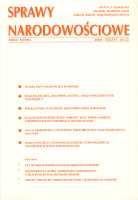Slovenian nationalism
Slovenian nationalism
Author(s): Veronika BajtSubject(s): Politics / Political Sciences
Published by: Instytut Slawistyki Polskiej Akademii Nauk
Keywords: Slovenian national movement; ethnic nation; Carniolan identity; the inclusion of the Slovenes in Yugoslavia; Tito
Summary/Abstract: The article presents the rise of Slovenian nationalism as an ideology founded and spread by the Slovenian national movement. As an opening remark the author stresses that nationalism is a modern phenomenon. She also introduces the division between ethnic nation (Kulturnation, narod) and political nation (Staatsnation, nacjia). The Slovenes first defined themselves as an ethnic nation but having gained their own nation-state in 1991, nowadays, they are free to redefine their nation in civic terms. The dynamics of Slovenian nation-building unfolded in agreement with the Czech historian Miroslav Hroch’s scheme. It shows that ethnic nation states start as an idea of a handful of intellectuals, before the national message is taken up and spreads among the members of the postulated nation. Then the nation has commenced its existence indeed. The term ‘Slovenia’ though known since the 16th century, intellectuals have used it consistently for denoting the Slovenian nation only after 1848. Still the Carniolan identity persisted. The 1840 national program demanded the administrative unification of the lands inhabited by Slovenes, Slovenian as a medium of education, and it opposed the construction of a German nation-state that would include the Austrian Empire along with Slovenia. Like the Czechs of Bohemia, the Slovenes did not crave for independence but Vienna’s protection. In the second half of the 19th century the mass Slovenian national movement grew frustrated by the progress of German nationalism and the continuing division of the Slovenian lands between Austria, Hungary, and Italy. Only during World War I the idea of independence gained popularity but was not actualized due to the inclusion of the Slovenes in Yugoslavia. It appeared a backward and heavily centralized state that thwarted the national goals of the Slovenes despite the administrative unification of almost all their lands. Another World War split Slovenia among Germany, Hungary and Italy so communist Yugoslavia appeared the only way to ensure national survival. Federalization of this state with a national republic for the Slovenes too, did not ensure economic stability. This bred discontent in Slovenia – Yugoslavia’s richest region – and spawned systemic-cum-nationalist opposition during the 1960s and 1970s. After Tito’s death (1980), in the next decade Slovenian politicians and intellectuals openly advocated independence. The establishment of the independent Slovenian nation-state finally fulfilled the program of Slovenian nationalism as well as commenced the breakup of Yugoslavia.
Journal: Sprawy Narodowościowe
- Issue Year: 2004
- Issue No: 24-25
- Page Range: 9-32
- Page Count: 24
- Language: English

